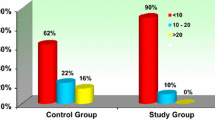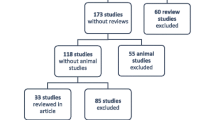Abstract
Purpose
Preterm prelabour rupture of membranes (PPROM) is a leading cause of preterm births. Its attendant contribution to maternal and perinatal morbidity and mortality makes it imperative to identify factors that may help prevent this condition. This study examined the association between plasma vitamin C concentration and the risk of (PPROM) amongst pregnant women in a tertiary hospital setting.
Methods
This was a prospective cross sectional study conducted at the Obstetric and Gynaecology Department of University of Benin Teaching Hospital (UBTH), Benin City. The study was in two phases, first a pilot study to determine baseline plasma vitamin C concentration amongst pregnant women in UBTH was conducted. In the main study 80 pregnant women were recruited into two groups of those with PPROM (40 cases) and those without PPROM (40 controls) matched for gestational age. Plasma vitamin C concentration was determined for all study participants and their sociodemographic characters were used to generate a database for analysis.
Results
In the pilot study, plasma vitamin C concentration decreased with increasing gestational age of pregnancy. In the main study plasma vitamin C concentration was significantly lower in women with PPROM than controls without PPROM, 0.53 ± 0.05 vs. 0.58 ± 0.05 mg/dl; P = 0.0001. Both groups (case and control) were comparably matched in age, parity and social class. There was a significant association between low vitamin C levels and the occurrence of PPROM (95% CI 1.53–11.88; P = 0.008).
Conclusion
Plasma vitamin C was found to be lower in women with PPROM. Low plasma vitamin C concentration may thus be an associated risk factor for PPROM. Hence improved dietary or drug supplements may be a useful adjunctive strategy to reducing the incidence of PPROM and its attendant adverse sequelae. While this intervention is advocated, further multicentre investigation of the effects of vitamin C on risk of preterm PROM is suggested.
Similar content being viewed by others
References
Mercer BM (2003) Preterm premature rupture of the membranes. Obstet Gynaecol 101(1):178–193
Obi SN, Ozumba BC (2007) Preterm premature rupture of foetal membranes: the dilemma of management in a developing nation. J Obstet Gynaecol 27(1):37–40
Parry S, Strauss JF (1998) Mechanisms of disease: premature rupture of the fetal membranes. N Engl J Med 338:663–670
Aboyeji AP, Abdul IF, Ijaiya MA, Nwabuisi C, Ologe MO (2005) The bacteriology of prelabour rupture of membranes in a Nigerian Teaching Hospital. J Obstet Gynaecol 25(8):761–764
Kundtson EJ, Smith K, Mercer BM, Miodovnik M, Thurnau GA et al (2004) Serum homocysteine levels after preterm premature rupture of the membranes. Am J Obstet Gynacol 191(1):537–541
Mathews F, Neil A (2005) Antioxidants and preterm prelabour rupture of the membranes. BJOG 112(5):588–594
Ferguson SE, Smith GN, Salenietes ME, Windrim R, Walker MC (2002) Preterm premature rupture of membranes. Nutritional and socioeconomic factors. Obstet Gynaecol 100(1):1250–1286
Casanueva E, Ripoll C, Meza-Camacho C, Coutino J, Ramirez-peredo J, Paira A (2005) Possible interplay between vitamin C deficiency and prolactin in pregnant women with premature rupture of membranes: facts and hypotheses. Med Hypotheses 64(2):241–247
Woods JR, Plessinger MA Jr, Miller RK (2001) Vitamin C and E: missing links in preventing preterm premature rupture of membranes? Am J Obstet Gynaecol 185(1):5–10
Wideman GL, Baird GH, Bolding OT (1964) Ascorbic acid deficiency and premature rupture of fetal membranes. Am J Obstet Gynaecol 88:592–595
Kanayama N, Terao T, Kawashima T, Horiuchi K, Fujimoto D et al (1985) Collagen types in normal and prematurely ruptured amniotic membranes. J Obstet Gynaecol 153:899–903
Plessinger MA, Woods JR, Miller RK (2000) Pretreatment of human amnion-chorion with vitamin C and E prevents hypochlorous acid induced damage. Am J Obstet Gynaecol 183(1):979–985
Steyn PS, Odendaal HJ, Schoeman J, Stander C, Fanie N et al (2003) A randomized double-blind placebo-controlled trial of ascorbic acid supplementation for the prevention of preterm labour. J Obstet Gynaecol 23(2):150–155
Casanueva E, Ripoll C, Tolentino M, Morales R, Pfeffer F et al (2005) Vitamin C supplementation to prevent premature rupture of the chorioamniotic membranes: a randomized trial. Am J Clin Nutr 81:859–863
Casanueva E, Vadillo-ortega F, Pfeffer F, Tejero E (1998) Vitamin C and premature rupture of chorioamniotic membranes. Nutr Res 18(2):241–245
Oboro VO, Adekanle BA, Apantaku BD, Onadipe OA (2006) Preterm prelabour rupture of membranes. Effect of chorioamnionitis on overall neonatal outcome. J Obstet Gynaecol 28(8):740–743
HO W (1997) Recommended definition, terminology and format for statistical tables related to the perinatal period. Acta Obstet Gynaecol Scand 56:247–253
Royal College of Obstetrics and Gynaecology (2006) Preterm prelabour rupture of membranes. Greentop Guideline No. 44: RCOG
Olusanya O, Okpere E, Ezimokhai M (1985) The importance of social class in voluntary fertility control in a developing country. West Afr J Med 4:205–212
Idogun ES, Odiegwu ME, Momoh SM, Okonofua FE (2008) Effects of pregnancy on total antioxidant capacity in Nigerian women. Pak J Med Sci 24(2):292–295
Olayaki LA, Ajao SM, Jimoh GA, Aremu IT, Soladoye AO (2008) Effect of vitamin C on malondialdehyde (MDA) in pregnant Nigerian women. J Basic Appl Sci 4(2):105–108
Hassan GI, Onu AB (2006) Total serum vitamin C concentration in pregnant women; implications for a healthy pregnancy. Rev Bras Saude Matern Infant Recife 6(3):293–296
Nwagha UI, Ejezie FE (2005) Serum ascorbic acid levels during pregnancy in Enugu, Nigeria. J Coll Med 10(1):43–45
Awoyelu CO, Agharanya JC, Oguntibeju OO (2004) Ascorbic acid status in third trimester of pregnancy, at delivery and in cord blood. Indian J Clin Biochem 19(1):54–56
Foghaha MH, Keshavarz T, Parsanezhad ME, Rajaeefard AR (2009) The effect of vitamin C on premature rupture of membranes and preterm labour in Shiraz, Southern Iran. IRCMJ 11(2):226–227
Barrett BM, Sowell A, Gunter E, Wang M (1994) Potential role of ascorbic acid and beta carotene in the prevention of preterm rupture of fetal membranes. Int J Vitam Nutr Res 64:192–197
Spinnato JA II, Freire S, Pinto e Silva JL, Rudge MV, Martins-Costa S et al (2008) Antioxidant supplementation and premature rupture of the membranes. A planned secondary analysis. Am J Obstet Gynaecol 199(4):433.e1–433.e8
Nino BV, Shaw N (1978) Vitamins. In: Teitz (ed) Fundamentals of clinical chemistry. WB Saunders & Co, Philadelphia, pp 547–550
Chiplonkar SA, Agte VV, Mengale SS, Tarwadi KV (2002) Are lifestyle factors good predictors of retinol and vitamin C deficiency in apparently healthy adults? Eur J Clin Nutr 56:96–104
Shectman G, Byrd JC, Hoffman R (1991) Ascorbic acid requirements for smokers: analysis of a population survey. Am J Clin Nutr 53:1466–1470
Conflict of interest
We declare that we have no conflict of interest.
Author information
Authors and Affiliations
Corresponding author
Rights and permissions
About this article
Cite this article
Osaikhuwuomwan, J.A., Okpere, E.E., Okonkwo, C.A. et al. Plasma vitamin C levels and risk of preterm prelabour rupture of membranes. Arch Gynecol Obstet 284, 593–597 (2011). https://doi.org/10.1007/s00404-010-1741-5
Received:
Accepted:
Published:
Issue Date:
DOI: https://doi.org/10.1007/s00404-010-1741-5




